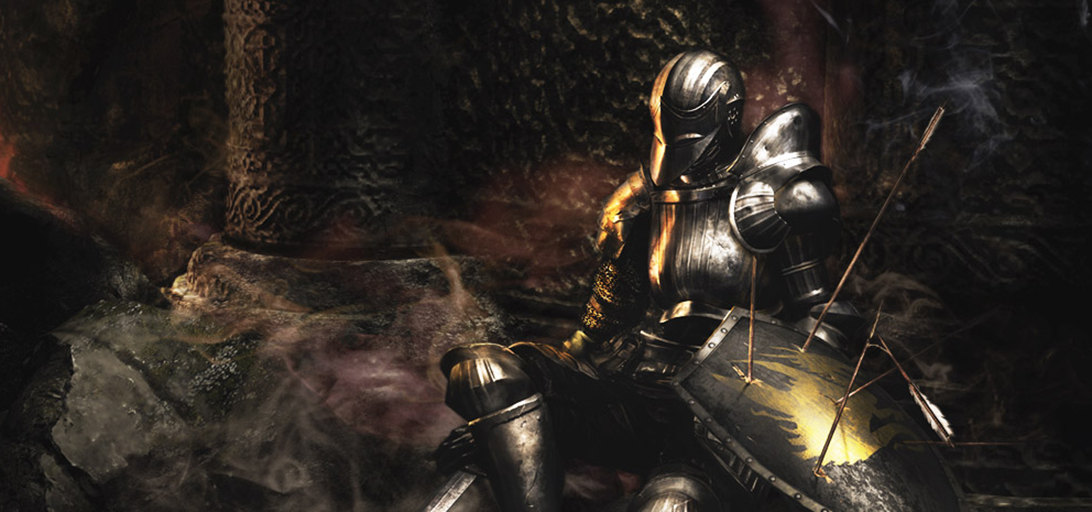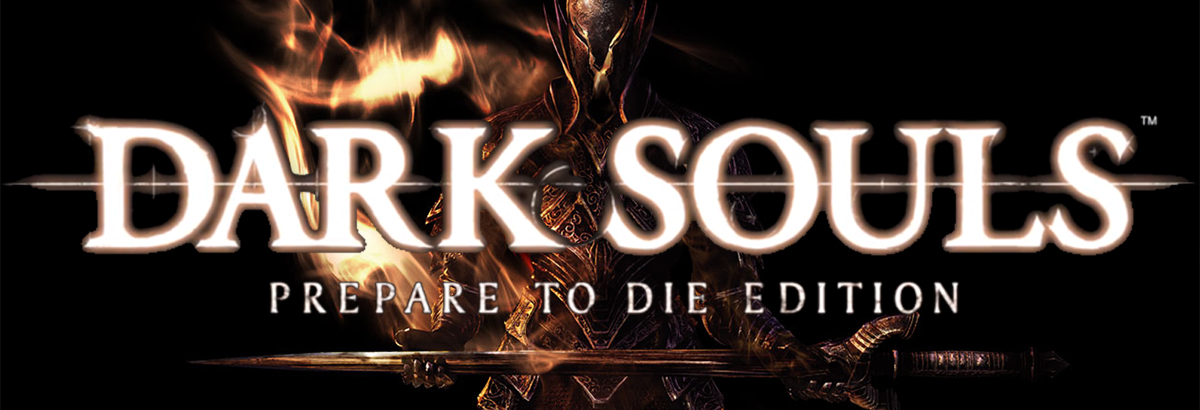To celebrate the recent release of a new and expanded edition of From Software’s peerless Role-Playing Game ‘Dark Souls’, I’ll try to scratch the surface of what makes this game so incredible.
Dark Souls: Prepare to Die (360, PS3, PC)
On August 24th, ‘Dark Souls‘ arrived on PC with expanded content, including more areas, bosses, items and a new PVP matchmaking system. Namco Bandai has promised that the ‘Prepare to Die’ extra content will eventually be available for the PS3 and 360 versions as well.
Understanding ‘Dark Souls’, as well as its predecessor and sibling ‘Demon’s Souls‘, is difficult from second-hand information. The game excels in a number of areas and achieves an immersive gameplay seldom found these days. While I can try to focus on one element to illustrate the game’s unique and rewarding nature (such as the level design, or the art style, the combat system, the story, the enemies, the secrets, the online system, etc.), it’s the culmination of all these things that makes this game a masterpiece.
The game is never hesitant to introduce a new element that the player won’t fully understand (or even remotely need to), and that can be odd at first. For instance, starting a new game involves selecting the appearance for your character. This is common in games and RPGs, and it’s easy to drop 20 minutes messing with the physical appearance of the player character. In this game, however, that really serves little purpose, as you almost never actually see the character’s face, even if you decide not to use any kind of helmet. The player’s appearance is just something available in one part of the game, and a lot of ‘Dark Souls’ is like this. In fact, there’s almost no music in the game. Outside of boss battles and the main hub area, silence replaces music. The player will quickly learn that noise means an enemy is nearby preparing to strike.
The game’s story involves the idea of “hollowing.” A corruption is causing people to become progressively closer to hollow, which is an undead-like state with loss of sanity. The player character is essentially somewhat hollow all the time, but still retains free will, and can do some things to become un-hollow. This brings us to where the player begins the game.
In the Tutorial
The player begins the game forgotten and locked in a cell in the Undead Asylum, a tutorial area separate from the main sprawling world of ‘Dark Souls’. Luckily, a knight appears high above the player and drops a key through the grate before departing. This knight (at least he looks like a knight) is clearly much better off in the world than the player. The knight is armed and armored, and not stuck in a cell awaiting a corrupt end. This knight is the high standard of the world, and the player character should aspire to make the best of this magnanimous warrior’s aid.
After leaving the cell and obtaining both a broken sword and pathetic shield, the player will find a stairway that leads up towards daylight. If, upon seeing the stairway, the player runs right up it, it’s likely that the undead enemy soldier at the top of the stairs will kill the player with a giant rolling ball. This is ‘Dark Souls’, where a stairway that might seem harmless actually contains an instant death.
Whether the bolder-like ball kills the player or not isn’t really important. As much as the game is about enemies and other things that re-spawn or reset upon death and saving, the game is also full of one-time events, acquisitions and kills. What’s important is that the giant ball breaks through a wall, opening a room that the player previously spied but couldn’t access. And whom does the player find? None other than the worldly knight that had dropped the player a key. The knight is down and just about out. The former badass made a misstep. (Maybe he ran up a stairway before checking it.) He quickly gives the player some items and asks a favor: Finish what the knight started, or else he’ll become completely hollow.
There are little theatrics here. There’s no cut-scene, no dialogue tree, and no prompt for the player to choose. Attack the knight and he dies. Otherwise, he just seems to expire. Of course, if the player leaves the knight alone and comes by the area a little later, he’ll find a hollow knight with murderous intent to deal with.
The Challenge
‘Dark Souls’ is challenging. Even the weakest enemies can gang-up or find a way to overcome a careless player. For the most part, I won’t accept any declarations that the game is cheap in its player deaths. The game is very consistent. If an enemy looks ominous, or is huge and looks tough, the player can expect just that.
An early convention in the game is to find large (20% larger than the player) black knights who guard pickups. The sensible choice, if the player still has to be careful when fighting scrubbier enemies, is to back away from these knights. If the black knight becomes aggressive, then the best option is to run as fast as possible somewhere else. The black knights can’t climb ladders, so finding a ladder is a good idea.
Part of the beauty of ‘Dark Souls’ is that if the player wants that pickup or even wants to kill the black knight, both are possible. One strategy would be to try to get by the dark knight, grab the item, and then die. The player will retain the item after death, but getting by the black knight might take a few tries. Letting the black knight give chase while occasionally fighting back is another option. Just hit him enough before he can kill you and he will die, never to re-spawn again.
The Devious Knight
I watched a friend play ‘Dark Souls’ and tried to coach him as best I could. ‘Dark Souls’ uses a variant of the old ‘Legend of Zelda’ z-targeting to allow the player to stay focused on an enemy while moving in third person. My friend had a hard time with this and subsequently wasn’t very good at dodging enemy attacks. Blocking works, but the game has a system where enough force will stagger you or an enemy (enemies can also be staggered), and you’re then completely vulnerable. This makes dodging quite valuable.
So, I told my friend to avoid a stairway that led up a tower to a black knight, and now it was time to say “What the hell, let’s see what happens.” As my friend attempted to take on the black knight, it was instantly clear that the knight wouldn’t die first. I gave the command to run away, and I advised him to make for a switch where he could close a door between him and the knight. Amazingly, my friend pulled it off, trapping the black knight on the other side of this door. This meant that my friend had to take another path forward to get to the church with the bell gargoyles.
As my friend made his way forward, I felt confident that I knew where all the enemies were in this area. Suddenly, I sensed danger, and I advised my friend to peer around the next corner. What do you know, that black knight that had been cut off from his normal spot had walked all the way around and was waiting just around the corner to kill my friend.
That is ‘Dark Souls’. Where I thought I had seen everything that the game could do in this area, something completely unexpected happened. That’s not something that you find in most games.

Demons Souls – Original Cover Art
The above image is the basis of the original cover art for ‘Demon’s Souls’. The player character is down with a shield full of arrows. Whether the character is dead, dying, or just taking five before rallying is in the eye of the beholder.
So Much More
Even before the expansion, ‘Dark Souls’ has several excellent and memorable areas like “The Great Hollow,” a hollowed-out tree with a series of twisting branches and roots leading down to hidden treasures. You can play through the game and reach the credits without ever finding that. “Sen’s Fortress,” with its many traps and a vertical ascent, is definitely a favorite area of mine. If the player returns to the tutorial “Undead Asylum” area and grabs the peculiar-looking doll, the optional “Painted World of Ariamis” will become accessible.
I’d be remiss if I didn’t mention the many excellent bosses. Making a boss fight is difficult, and not always a strength of games produced in the Western hemisphere. ‘Dark Souls’ is a powerhouse of boss battles. From the visual design, to the many different fighting techniques, to the gravity imparted to the player, each boss fight is a clinic on making a memorable, challenging and fun boss.
At the end of another of the game’s great areas, “Blight Town,” is the lair of Quelaag, one of the Daughters of Chaos. In keeping with a main theme of the game, the Daughters of Chaos have long been corrupted by the power that they possess. In practical respects, Quelaag is like a centaur, except half woman and half giant lava-spewing spider. In short, the key to defeating her is to avoid the lava spews and block the half-woman’s fire sword strikes. Only after destroying Quelaag will the player discover her sister, who is bound in place and is unable to understand anyone’s language except for her sister that the player just killed. There’s a way to talk to this tragic creature, but at best, she won’t really understand who the player is and will always expect her sister to return and speak with her eventually.
If only Konami had taken the ‘Castlevania’ franchise in this direction, instead of the ‘Lord of Shadows’ direction, with its heavy voiceover and lack of good gameplay.
Playing Online
‘Dark Souls’ also has an online system that could be a whole article unto itself. Should the player become completely un-hollow by spending a precious resource called Humanity, the player can summon other players into the game to assist with bosses, among other things. However, this also makes the player vulnerable to a more malicious player-versus-player system. The game has covenants that are wrapped up in the online aspects. One covenant rewards invading other players’ games and defeating them. Another covenant rewards assisting other players. Another covenant rewards invading the worlds of players who have become guilty by defeating “innocent” players.
While this is all very elaborate, the game uses a note system that applies regardless of player status. Essentially, a player can drop a note on the ground and, by choosing from a set of words and messages, can signal other players about secrets and where to be cautious. Other players on the same server can see these notes and rate them either +1 or -1.
Aside from that rating, there’s nothing to prevent misdirection. An honest and helpful note might say “Forward” at a spot that seems like a bottomless pit, but is actually a hidden item. A dishonest note might say “Forward” at what is actually a bottomless pit. Another player might leave a nearby note saying “Liar” to signal the falsehood. In a game where a treasure chest may actually be a relentless creature with a huge mouth full of teeth, these notes can be very helpful, and really add a sense of shared journey to what might normally be an isolated experience.
One more fun online detail involves the two bells. An early goal for the player is to ring two bells that mark milestones in the game. When the player gets near one of the bells, its ringing may signal that another player on the same server has rung the bell in his own game.
Even though many players who try ‘Dark Souls’ quit before getting to experience much of the game, I still heartily recommend that anyone with a Xbox 360, PS3 or a decent PC give the game a shot.





